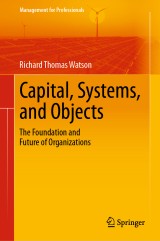Details

Capital, Systems, and Objects
The Foundation and Future of OrganizationsManagement for Professionals
|
53,49 € |
|
| Verlag: | Springer |
| Format: | |
| Veröffentl.: | 01.12.2020 |
| ISBN/EAN: | 9789811594182 |
| Sprache: | englisch |
Dieses eBook enthält ein Wasserzeichen.
Beschreibungen
<p><p>This book provides a set of integrated frameworks—capital, systems, and objects—that transcend managerial or technology hype by focusing on the long-term fundamentals that sustain organizational success. Many organizations are currently addressing two important transformational issues: ecological sustainability and digitization. Sustainability is a goal, an end, and digitization is a process, a means to achieve a goal. This book introduces a flexible model that can be applied to current and future organizational challenges, including sustainability and digitization, because the fundamentals are constant.<br></p>
<p>This book is designed to serve two purposes for the readers: first, to present three conceptual foundations for designing and operating organizations (capital, systems, and objects in Part I); and second, to provide a reference source for implementing these ideas in an organization (Parts II and III). The Part I of the book, chapters 1 through 7, sets forth the conceptual foundations. The chapters mix concepts and practical examples to give a new way of thinking about the setting in which one may work many days each year. The Part II provides details and associated examples of every one of the thirty-six forms of capital conversion. It also illustrates how the five foundational systems support capital conversion in a variety of ways. Finally, the Part III is about measuring capital and systems.</p>
<p>The book will resonate with practitioners and students of strategy, leadership, and organizational design. It is critical reading for leaders, industry experts, and general readers who want to understand how over thousands of years the capital creation system has developed today’s world and will fashion its future.</p><br></p>
<p>This book is designed to serve two purposes for the readers: first, to present three conceptual foundations for designing and operating organizations (capital, systems, and objects in Part I); and second, to provide a reference source for implementing these ideas in an organization (Parts II and III). The Part I of the book, chapters 1 through 7, sets forth the conceptual foundations. The chapters mix concepts and practical examples to give a new way of thinking about the setting in which one may work many days each year. The Part II provides details and associated examples of every one of the thirty-six forms of capital conversion. It also illustrates how the five foundational systems support capital conversion in a variety of ways. Finally, the Part III is about measuring capital and systems.</p>
<p>The book will resonate with practitioners and students of strategy, leadership, and organizational design. It is critical reading for leaders, industry experts, and general readers who want to understand how over thousands of years the capital creation system has developed today’s world and will fashion its future.</p><br></p>
<p>Chapter 1: A Capital Idea.- Chapter 2: The Organization as a Capital Creation System.- Chapter 3: The Growth of the Capital Creation System.- Chapter 4: Systems for Creating Capital.- Chapter 5: Energy for Capital Creation.- Chapter 6: Objects.- Chapter 7: The Future.- Section 2: Capital Creation Mechanisms.- Chapter 8: Economic Capital.- Chapter 9: Human Capital.- Chapter 10: Organizational Capital.- Chapter 11: Natural Capital.- Chapter 12: Social Capital.- Chapter 13: Symbolic Capital.- Section 3: Capital and Systems Measurement.- Chapter 14: The Measurement of Capital.- Chapter 15: The Measurement of Systems.</p>
<p>Richard Watson is a Regents Professor and the J. Rex Fuqua Distinguished Chair for Internet Strategy in the Terry College of Business at the University of Georgia. In 2011, he received the Association for Information Systems' LEO award for exceptional lifetime achievement in Information Systems. The University of Liechtenstein has established with government support a Consortium for Digital Capital Creation based on the ideas in this book. <br></p>
<div><p>This book provides a set of integrated frameworks—capital, systems, and objects—that transcend managerial or technology hype by focusing on the long-term fundamentals that sustain organizational success. Many organizations are currently addressing two important transformational issues: ecological sustainability and digitization. Sustainability is a goal, an end, and digitization is a process, a means to achieve a goal. This book introduces a flexible model that can be applied to current and future organizational challenges, including sustainability and digitization, because the fundamentals are constant.</p></div><div><p>This book is designed to serve two purposes for the readers: first, to present three conceptual foundations for designing and operating organizations (capital, systems, and objects in section 1); and second, to provide a reference source for implementing these ideas in an organization (sections 2 and 3). The first section of the book, chapters 1through 7, sets forth the conceptual foundations. The chapters mix concepts and practical examples to give a new way of thinking about the setting in which one may work many days each year. The second section provides details and associated examples of every one of the thirty-six forms of capital conversion. It also illustrates how the five foundational systems support capital conversion in a variety of ways. Finally, the third section is about measuring capital and systems.</p></div><div><p>The book will resonate with practitioners and students of strategy, leadership, and organizational design. It is critical reading for leaders, industry experts, and general readers who want to understand how over thousands of years the capital creation system has developed today’s world and will fashion its future.</p></div>
Provides valuable insights on how to be an effective capital creator – the world’s number one game Lays out how to build a well-defined and shared understanding of an organization’s capital creation system which is a necessary first step to strategic planning and digital transformation Explains the five fundamental systems for creating and maintaining six type of capital and how these should be the focus of any digital transformation effort
















